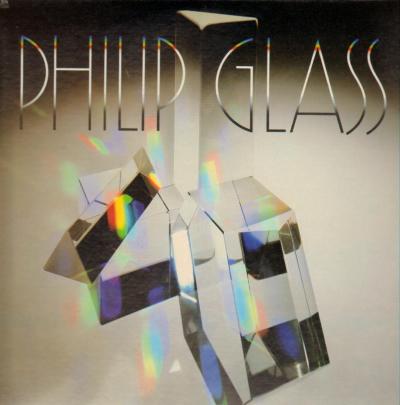
Glassworks by Philip Glass (1982)
The first time I thought I heard Philip Glass, about ten years ago, I was not particularly impressed. Initially, my feeling was that his music was a rather pretentious effort to sound ultra-minimalist and avant garde. I don’t recall which piece I was hearing, but it seemed pretty repetitive and mechanical. “What do people hear in this music? I don’t get it,” I grumbled to myself.
But again, let me say that I thought it was the first time I had heard Philip Glass. Actually, the first time I heard him was in 1986 when I watched the masterpiece film (or perhaps “extended music video” is a more appropriate term) Koyaanisqatsi (1983) when it was shown on television in its entirety as a PBS special. Philip Glass did the complete soundtrack for this deeply meditative, visually poetic, and profoundly disquieting movie, which takes a hard and uncompromising look at what modern humanity has become. Actually, it might be more accurate to say that the film itself was made to accompany the Koyaanisqatsi album. At any rate, Glass’s music and the accompanying images complement one other perfectly in one of the most deeply moving cinematic experiences I’ve ever had.
At the insistence of a friend, I recently saw Koyaanisqatsi again, and at that time learned that Glass was the composer for its soundtrack. This experience caused me to rethink my views on Philip Glass, and I investigated some of his other recordings. I discovered that Glass’s body of work is highly varied in terms of style and, at least in my personal view, quality, but then again, my musical tastes tend a bit more towards the traditional than the experimental, so I make no claims of objectivity in that regard. As I see it, Glass is at his best when he is most accessible to the general public. Conversely, he has probably earned the most praise from the ivy-league academic music community for his most difficult and challenging pieces, many of which sound like drawn-out versions of The Beatles’ “Revolution Number Nine,” but my feeble efforts to appreciate and enjoy such compositions have sadly borne little fruit indeed. I leave it up to more refined ears to savor Glass’s highest expressions of cutting-edge artistic sensibility.
Among the several works by the composer which I have perused, the one I appreciate best, perhaps aside from Koyaanisqatsi, is Glassworks (1982), which came out the year before Koyaanisqatsi, and shares to a large extent the movie soundtrack’s structure and feel. In fact, I think it entirely possible that Glass took material rejected for Glassworks and repurposed it for Koyaanisqatsi, since the two albums are so similar.
For those of you who are not familiar at all with Phillip Glass but would like to know more, Glassworks is probably the best place to start, since it isn’t too long, is more traditional in format, and gives a fairly comprehensive overview of Glass’s unorthodox and highly distinctive style of popular postmodern classical composition. To a large extent, it has the typical structure of a pop album, meaning that it consists of relatively short pieces, each with a common melodic theme. In this case, the entire album is about forty minutes long, which is divided up among six pieces of approximately equal length, that is, between six and eight minutes each. The album is entirely instrumental, and primarily makes use of classical instruments, although there’s a good dose of keyboard synthesizers in the mix as well. Simple repetition, quick notes with slowly advancing chord progressions, and small-scale complexity are the hallmarks of the composer’s work. For lack of a better term, I would call Glassworks an example of musical impressionism, but I’m sure there’s a big nose out there who knows better than I do, and I welcome him/her to set the record straight in the little comment box at the end of this article.
Here’s a discussion of the individual compositions:
Opening:
The initial piece consists entirely of piano, which is played at a steady, unwavering pace from beginning to end. It’s a melancholy yet uplifting tune, which in my mind seems to suggest that you can obtain your greatest insights and inspirations in your most profound moments of hopelessness and despair. The piece consists of a number of key modulations, which gives me the sensation of looking at an emotional experience from a number of different viewpoints and perspectives.
Floe:
Transitioning from “Opening,” this piece begins with a lonely horn holding a long note, as if to summon a group of nobles to a medieval banquet hall, and then abruptly gives way to a frenetic series of mechanically repeating synthesizer notes mixed in with classical woodwinds and brass. At some moments, it’s hard to tell which one is the synthesizer, and which ones are the classical instruments. The piece builds in intensity to the end, then abruptly ceases.
Island:
This contrasts the busyness of “Floe” with a much slower pace and considerably less instrumentation. The sparse feel of the piece does indeed make me think of a desert island in the middle of the sea with a series of slow waves coming in to its shore as palm leaves rustle in a light breeze. However, there is an element of almost imperceptibly building tension in the peaceful music, as if the clouds are progressively darkening away on the watery horizon, and occasional flashes of distant lightning are seen. It makes you wonder if your little island refuge might not eventually end up being lashed by some terrible hurricane.
Rubric:
Similar to “Floe,” this piece is full of crowded, frantic notes and abundant instrumentation, and is distinguished by a largely mechanical feel. I have to wonder if Glass copied some of the sounds and rhythms from a printing press, an automated typewriter from the early 1980’s, or maybe a teletype machine of some kind. Pure art-deco music, if you ask me. It has an urban feel to it, and calls to my mind scenes of New York City hustle and bustle filmed at ultra-low speed and played back normally, as was done in Koyaanisqatsi, in other words, human activity implicitly compared to the frantic and mindless comings and goings within ant farms.
Façades:
Glass once again swings the mood back to somber and grey. The arrangement here is comparatively simple, with stringed instruments skillfully intertwining with woodwinds. The pattern of the composition seems almost like a weaving design of sorts. The title, “Façades,” may have a double meaning, possibly referring to the fronts of buildings as well as the false pretense of personalities. Perhaps in Glass’s mind, the two are really one and the same in our heavily urbanized environments.
Closing:
The melody from “Opening” is repeated here, but with richer instrumentation involving some stringed instruments and woodwinds. The piano from the first track is repeated, but the playing is slightly different, perhaps at a somewhat higher pitch. The effect is to add an even greater poignancy to the haunting melody. It’s a fitting and effective way to close out this generally sparse yet strangely fulfilling album.
I’m kind of hard-pressed to speculate about who this album might appeal to. Glassworks seems to incorporate elements of pop music, postmodernist classical music, and electronica, without fully exhibiting the key characteristics of any of those categories. As luck would have it, I have an interest in all three of those styles, so I can enjoy Philip Glass’s work. It could be that if you’ve been a fan of pop music for many years, Glass just might be your best introduction to postmodernist classical music. And if you are already well-versed in electronica, you should check out Glassworks, if only to acquaint yourself with an early and noteworthy pioneer of the genre.
Reviewed by Somebody Else 2/1/14
See more Favorite Albums of the Moment





